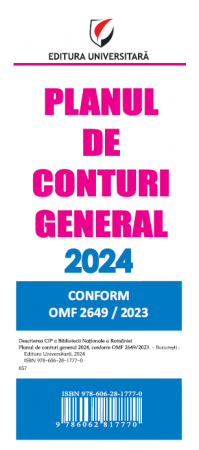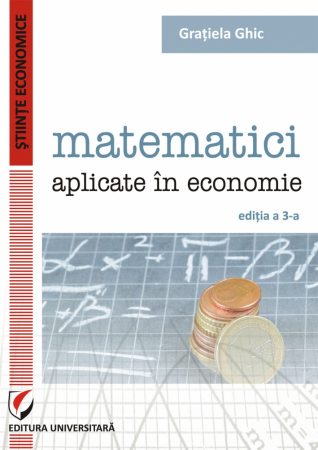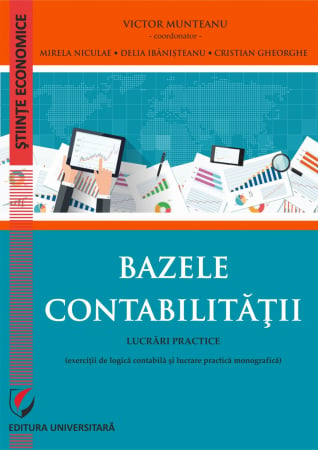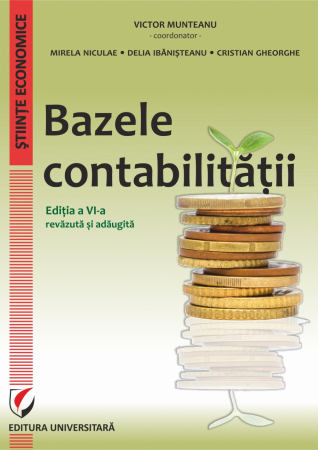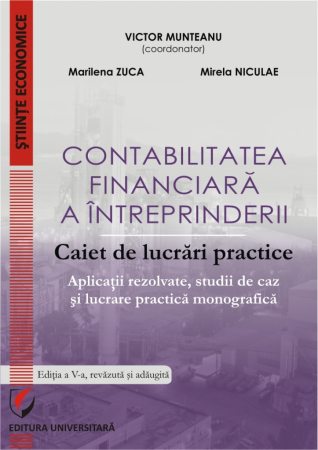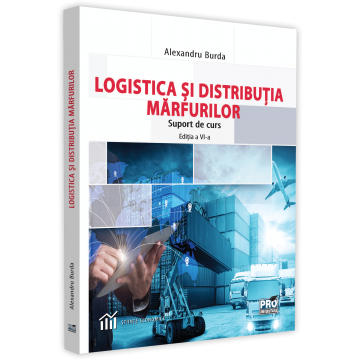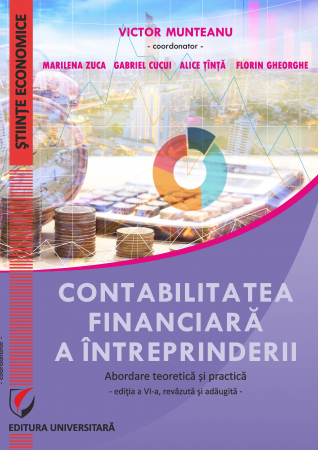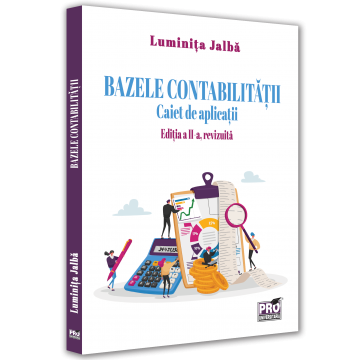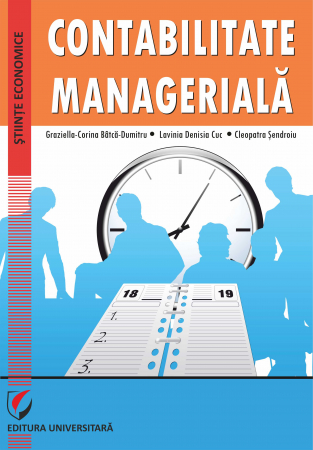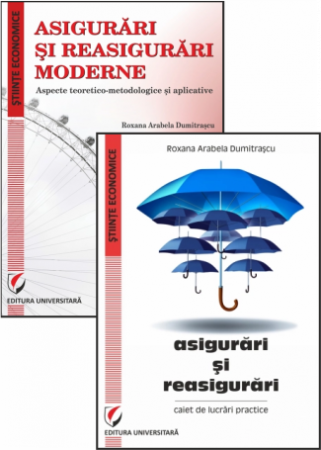Manuscript proposals: [email protected] / 0745 204 115 //// Tracking orders Individuals / Sales: 0745 200 357 / Orders Legal entities: 0721 722 783
Publisher: Editura Universitară
Author: Catalin Ghinararu, Adriana Ana Maria Davidescu
ISBN: 978-606-28-0384-1
DOI: 10.5682/9786062803841
Publisher year: 2015
Edition: I
Pages: 92
Product Code:
9786062803841
Do you need help?
0745 200 357
- Description
- Download (1)
- Authors
- Content
- More details
- Reviews (0)
The volume tries to discuss how Romania can face the challenge posed by the need to green or "green" the economy as aging and migration clearly threaten the potential to generate gross domestic product and finally to generate national wealth (" "greening" of the economy mainly involves the generation of assets specific to national wealth rather than the generation of gross domestic product. In other words, greening returns the paradigm of measuring the global output of economic activity from gross domestic product, back to national wealth). If not there are not many answers at the moment because the processes are still in their infancy and the fluidity of the economic environment is maximum after the random exogenous shock of the crisis of 2008-2009 and the economic depression that followed and from which Europe has not yet emerged. however, ideas abound. By planting these ideas, we want to contribute to the growth of the national know-how meant to finally give adequate answers to the real challenges that, even in a brief way, we have stated above. Thus, if GREEN means a return to an approach oriented towards national wealth rather than gross domestic product, then GREEN IDEAS, or in other words NEW ideas, can certainly contribute to the increase of national wealth in the matter which in the 21st century will mean especially intellectual capital.
GREEN capital for a WORLD that does not age but simply: LIVE LONGER!
GREEN capital for a WORLD that does not age but simply: LIVE LONGER!
-
Verde si gri. Imbatranire activa si potential de creare de locuri de munca verzi in Romania
Download
ADRIANA ANAMARIA DAVIDESCU
CATALIN GHINARARU
CATALIN GHINARARU
Introduction / 7
CHAPTER I. IDENTIFYING THE TRANSFERABILITY POTENTIAL OF LABOR MARKET POLICIES AND MEASURES TO ENCOURAGE ACTIVE AGING / 13
1.1. Evaluation of the performances of the labor market policies in 2012 at the level of the EU states. included in the analysis / 15
1.2. Data / 27
1.3. Research methodology / 28
1.4. Empirical results / 31
1.4.1. Analysis of labor market measures and policies at global level / 31
1.4.2. Analysis of measures and labor market dedicated to encouraging active aging / 37
1.5. Preliminary conclusions of chapter / 43
CHAPTER II. QUANTIFICATION AND EX-POST ANALYSIS OF THE IMPACT OF MEASURES DEDICATED TO ACTIVE AGING IN IMPLEMENTATION / 46
2.1. Advanced statistical analysis of active aging measures existing on the Romanian labor market / 49
2.2. Impact of the measure intended to subsidize employers in order to employ the unemployed over 45 years of age on employment and unemployment among the elderly / 56
2.2.1. Data used / 56
2.2.2. Estimation methodology / 59
2.2.3. Empirical results / 63
2.3. Impact of the measure intended to subsidize employers in order to employ the unemployed who are 3 years old until retirement on employment and unemployment among the elderly / 75
2.3.1. Data used / 75
2.3.2. Estimation methodology / 77
2.3.3. Empirical results / 78
2.4. Preliminary conclusions of chapter / 79
Conclusions / 82
Bibliography / 88
CHAPTER I. IDENTIFYING THE TRANSFERABILITY POTENTIAL OF LABOR MARKET POLICIES AND MEASURES TO ENCOURAGE ACTIVE AGING / 13
1.1. Evaluation of the performances of the labor market policies in 2012 at the level of the EU states. included in the analysis / 15
1.2. Data / 27
1.3. Research methodology / 28
1.4. Empirical results / 31
1.4.1. Analysis of labor market measures and policies at global level / 31
1.4.2. Analysis of measures and labor market dedicated to encouraging active aging / 37
1.5. Preliminary conclusions of chapter / 43
CHAPTER II. QUANTIFICATION AND EX-POST ANALYSIS OF THE IMPACT OF MEASURES DEDICATED TO ACTIVE AGING IN IMPLEMENTATION / 46
2.1. Advanced statistical analysis of active aging measures existing on the Romanian labor market / 49
2.2. Impact of the measure intended to subsidize employers in order to employ the unemployed over 45 years of age on employment and unemployment among the elderly / 56
2.2.1. Data used / 56
2.2.2. Estimation methodology / 59
2.2.3. Empirical results / 63
2.3. Impact of the measure intended to subsidize employers in order to employ the unemployed who are 3 years old until retirement on employment and unemployment among the elderly / 75
2.3.1. Data used / 75
2.3.2. Estimation methodology / 77
2.3.3. Empirical results / 78
2.4. Preliminary conclusions of chapter / 79
Conclusions / 82
Bibliography / 88
The recently concluded Paris Conference on Climate Change managed to produce a document that provides measures to limit global warming somewhere between 1.5 and a maximum of 2 degrees Celsius. The measures will start to take effect in 2020 and will be partly binding, but will remain at the discretion of the signatory states to the Convention, which will manage to reduce CO2 emissions considered to be primarily responsible for global warming and climate change.
Even if these two terms are and remain contested, it is still not true that human activity at today's quotas brings in addition to benefits and costs for the Earth's natural environment, a planet that we all share in the end, whether we signed or not. certain international documents and whether or not we have assumed certain targets for reducing pollution or reducing the energy intensity of certain activities.
Under the Europe 2020 Strategy, EU member states have set even more ambitious targets, whereby energy from non-renewable sources must reach more than a quarter of energy production by the end of the decade. Some member states, the first of them being Germany, have even taken radical and of course contestable decisions to unilaterally give up energy produced from nuclear sources with costs that would of course be absolutely prohibitive for Romania but also for other member states in the eastern part of the European Union. whose economies are still subject to much higher competitive pressures than they could normally withstand given their overall level of development.
If in terms of energy sources Romania has practically managed to reach the targets specified in the Europe 2020 Strategy and assumed as a member state, and this especially due to the large share of energy generated in hydropower plants, however in terms of energy intensity of the economy, are much more to do. But the costs are prohibitively high and they add an element of non-competitiveness for the Romanian economy which, it must be acknowledged, although integrated into a club of developed economies, is and remains, like the economy of other states in central and eastern Europe, an economy development. This would imply for Romania rhythms of development practically once again the current ones (so GDP increases from one year to another of at least 7-8%, compared to 3-4% at present) and a much higher degree of regulation. lower than that imposed by the simple status of member of the European Union and asygel by the need to apply specific rules to some states whose degree of development far exceeds that of Romania and who, moreover, applied these rules when they were at a level of development clearly higher than that of today's Romania. In addition, Romania as a member state must comply with the rules of the single market, which, again, are quite unfavorable to a developing economy. Under these conditions, green for Romania means costs because it means either a very large investment effort of companies or the disappearance of some economic sectors, which would accentuate the pressure on the internal labor market. Under these conditions, the capacity to generate jobs, however reduced, would diminish, at least in the short and medium term.
In other words, for Romania, the green economy represents for the time being at least, a new challenge, not the last of course, from a long series of challenges quite difficult to bear for an insufficiently consolidated economic body.
But in line with what is happening in other European countries, this time, Romania's population is aging. This aging process, which is in stark contrast to the status of the developing economy, is overlapping with a process of sharp population decline due to labor migration in the same area of the European Union. At the same time, there is, at least formally, a sharp increase in the level of education of young generations of the Romanian population as a result of opening access to education and training after 1990 and especially after 2000. This makes the Romanian population and especially the active population to be subjected to the effects of three simultaneous processes: aging, reduction through migration and increasing the formal level of education and training (we are talking here about the level of education and training attested by diplomas or certificates recognized at least nationally without discuss in any way the "quality" of the act of education or vocational training). The first process leads in time to a decrease in the active population and even the employed one, despite the progressive raising of the standard retirement age (it is our qualified opinion that this progressive increase cannot be infinite because it would eventually lead upon the practical annulment of the right to a pension, a right won in Romania by individual contribution and whose ultimate guarantor is the Romanian state itself by the fundamental act of the Constitution). The second process leads to a general reduction in the population as well as its growth potential as the migration of women of childbearing age leads to a doubling of the pressure on the fertility rate. On the one hand, it decreases as a result of the increase in education, and on the other hand, the decrease is accentuated by the reduction of the contingent of women of childbearing age through migration. Both processes put excessive pressure in our opinion on the potential for economic growth as the population generates both gross domestic product and especially national wealth. If these two aggregates, the first feeding the second, do not increase both in real terms but also in nominal terms (in a climate with low inflation the nominal increase becoming the essential process!), It is difficult to distinguish a way in which the costs imposed by the greening of the economy could be borne, other than by a reduction of economic activity, which in turn would generate new population losses. So a vicious circle. But the third process is a positive one. Even disregarding the "quality" of the act of education and training, often appreciated as a mediocre case in Romania or even sub-mediocre, this increase in the general level of education remains an indisputable fact. In itself, this means that although lower in numbers, the labor supply is increasingly qualified. A numerically lower but better qualified job supply would put less pressure, at least in terms of the number of jobs generated on the job demand (employers). Of course the pressure would increase in terms of job quality. It is assumed, however, that as supply decreases but its quality increases, it could better cope with an environment in which demand would also be lower as a result of the automation of many production processes in industry and agriculture and would the increasing development of the service sector that would become the main provider of jobs in the economy (in fact if we take out of the equation agriculture where existing jobs have a special specificity, services are already the most important provider of jobs from the economy). In this context, the pressure of the first two processes would be compensated at least partially by the third process. In other words, the increased level of education and training would allow new cohorts to enter the labor market, in combination with a more proactive labor market behavior of current generations, compared to previous ones, which would substantially reduce the recourse to premature retirement. (which has become more difficult due to much more restrictive legislation than in the past) could offset the loss of gross domestic product due to migration and aging. In other words, the effect of aging could be substantially reduced if it is not already in sharp decline because the cohorts that currently constitute the backbone of the active population already have a changed behavior compared to previous cohorts (currently the base of the active population and employment is from the cohorts of the peak years in terms of births, so of the years 1967-1970 whose behavior is clearly different from that of previous cohorts due to the actual moment of entry into the labor market), while also in part, the effect of migration would it could be compensated in part by the increase in the level of education of those who remained. In other words, the loss of productivity and therefore the loss of gross domestic product should not be significant, in the absence of course of random exogenous shocks, which are difficult to predict but whose incidence can fundamentally alter the whole mechanism, either in good or bad. One of the keys to solving the situation here are the measures of active aging and especially that of prolonging the active life.
But this volume seeks to discuss how Romania can meet the challenge posed by the need to green or "green" the economy as aging and migration clearly threaten the potential for gross domestic product and ultimately that of generating national wealth ("greening" of the economy involves mainly the generation of assets specific to national wealth rather than the generation of gross domestic product. In other words, greening returns the paradigm of measuring the global output of economic activity from gross domestic product, back to wealth national). If not there are not many answers at the moment because the processes are still in their infancy and the fluidity of the economic environment is maximum after the random exogenous shock of the crisis of 2008-2009 and the economic depression that followed and from which Europe has not yet emerged. however, ideas abound. By planting these ideas, we want to contribute to the growth of the national know-how meant to finally give adequate answers to the real challenges that, even in a brief way, we have stated above. Thus, if GREEN means a return to an approach oriented towards national wealth rather than gross domestic product, then GREEN IDEAS, or in other words NEW ideas, can certainly contribute to the increase of national wealth in the matter which in the 21st century will mean especially intellectual capital.
GREEN capital for a WORLD that does not age but simply: LIVE LONGER!
Even if these two terms are and remain contested, it is still not true that human activity at today's quotas brings in addition to benefits and costs for the Earth's natural environment, a planet that we all share in the end, whether we signed or not. certain international documents and whether or not we have assumed certain targets for reducing pollution or reducing the energy intensity of certain activities.
Under the Europe 2020 Strategy, EU member states have set even more ambitious targets, whereby energy from non-renewable sources must reach more than a quarter of energy production by the end of the decade. Some member states, the first of them being Germany, have even taken radical and of course contestable decisions to unilaterally give up energy produced from nuclear sources with costs that would of course be absolutely prohibitive for Romania but also for other member states in the eastern part of the European Union. whose economies are still subject to much higher competitive pressures than they could normally withstand given their overall level of development.
If in terms of energy sources Romania has practically managed to reach the targets specified in the Europe 2020 Strategy and assumed as a member state, and this especially due to the large share of energy generated in hydropower plants, however in terms of energy intensity of the economy, are much more to do. But the costs are prohibitively high and they add an element of non-competitiveness for the Romanian economy which, it must be acknowledged, although integrated into a club of developed economies, is and remains, like the economy of other states in central and eastern Europe, an economy development. This would imply for Romania rhythms of development practically once again the current ones (so GDP increases from one year to another of at least 7-8%, compared to 3-4% at present) and a much higher degree of regulation. lower than that imposed by the simple status of member of the European Union and asygel by the need to apply specific rules to some states whose degree of development far exceeds that of Romania and who, moreover, applied these rules when they were at a level of development clearly higher than that of today's Romania. In addition, Romania as a member state must comply with the rules of the single market, which, again, are quite unfavorable to a developing economy. Under these conditions, green for Romania means costs because it means either a very large investment effort of companies or the disappearance of some economic sectors, which would accentuate the pressure on the internal labor market. Under these conditions, the capacity to generate jobs, however reduced, would diminish, at least in the short and medium term.
In other words, for Romania, the green economy represents for the time being at least, a new challenge, not the last of course, from a long series of challenges quite difficult to bear for an insufficiently consolidated economic body.
But in line with what is happening in other European countries, this time, Romania's population is aging. This aging process, which is in stark contrast to the status of the developing economy, is overlapping with a process of sharp population decline due to labor migration in the same area of the European Union. At the same time, there is, at least formally, a sharp increase in the level of education of young generations of the Romanian population as a result of opening access to education and training after 1990 and especially after 2000. This makes the Romanian population and especially the active population to be subjected to the effects of three simultaneous processes: aging, reduction through migration and increasing the formal level of education and training (we are talking here about the level of education and training attested by diplomas or certificates recognized at least nationally without discuss in any way the "quality" of the act of education or vocational training). The first process leads in time to a decrease in the active population and even the employed one, despite the progressive raising of the standard retirement age (it is our qualified opinion that this progressive increase cannot be infinite because it would eventually lead upon the practical annulment of the right to a pension, a right won in Romania by individual contribution and whose ultimate guarantor is the Romanian state itself by the fundamental act of the Constitution). The second process leads to a general reduction in the population as well as its growth potential as the migration of women of childbearing age leads to a doubling of the pressure on the fertility rate. On the one hand, it decreases as a result of the increase in education, and on the other hand, the decrease is accentuated by the reduction of the contingent of women of childbearing age through migration. Both processes put excessive pressure in our opinion on the potential for economic growth as the population generates both gross domestic product and especially national wealth. If these two aggregates, the first feeding the second, do not increase both in real terms but also in nominal terms (in a climate with low inflation the nominal increase becoming the essential process!), It is difficult to distinguish a way in which the costs imposed by the greening of the economy could be borne, other than by a reduction of economic activity, which in turn would generate new population losses. So a vicious circle. But the third process is a positive one. Even disregarding the "quality" of the act of education and training, often appreciated as a mediocre case in Romania or even sub-mediocre, this increase in the general level of education remains an indisputable fact. In itself, this means that although lower in numbers, the labor supply is increasingly qualified. A numerically lower but better qualified job supply would put less pressure, at least in terms of the number of jobs generated on the job demand (employers). Of course the pressure would increase in terms of job quality. It is assumed, however, that as supply decreases but its quality increases, it could better cope with an environment in which demand would also be lower as a result of the automation of many production processes in industry and agriculture and would the increasing development of the service sector that would become the main provider of jobs in the economy (in fact if we take out of the equation agriculture where existing jobs have a special specificity, services are already the most important provider of jobs from the economy). In this context, the pressure of the first two processes would be compensated at least partially by the third process. In other words, the increased level of education and training would allow new cohorts to enter the labor market, in combination with a more proactive labor market behavior of current generations, compared to previous ones, which would substantially reduce the recourse to premature retirement. (which has become more difficult due to much more restrictive legislation than in the past) could offset the loss of gross domestic product due to migration and aging. In other words, the effect of aging could be substantially reduced if it is not already in sharp decline because the cohorts that currently constitute the backbone of the active population already have a changed behavior compared to previous cohorts (currently the base of the active population and employment is from the cohorts of the peak years in terms of births, so of the years 1967-1970 whose behavior is clearly different from that of previous cohorts due to the actual moment of entry into the labor market), while also in part, the effect of migration would it could be compensated in part by the increase in the level of education of those who remained. In other words, the loss of productivity and therefore the loss of gross domestic product should not be significant, in the absence of course of random exogenous shocks, which are difficult to predict but whose incidence can fundamentally alter the whole mechanism, either in good or bad. One of the keys to solving the situation here are the measures of active aging and especially that of prolonging the active life.
But this volume seeks to discuss how Romania can meet the challenge posed by the need to green or "green" the economy as aging and migration clearly threaten the potential for gross domestic product and ultimately that of generating national wealth ("greening" of the economy involves mainly the generation of assets specific to national wealth rather than the generation of gross domestic product. In other words, greening returns the paradigm of measuring the global output of economic activity from gross domestic product, back to wealth national). If not there are not many answers at the moment because the processes are still in their infancy and the fluidity of the economic environment is maximum after the random exogenous shock of the crisis of 2008-2009 and the economic depression that followed and from which Europe has not yet emerged. however, ideas abound. By planting these ideas, we want to contribute to the growth of the national know-how meant to finally give adequate answers to the real challenges that, even in a brief way, we have stated above. Thus, if GREEN means a return to an approach oriented towards national wealth rather than gross domestic product, then GREEN IDEAS, or in other words NEW ideas, can certainly contribute to the increase of national wealth in the matter which in the 21st century will mean especially intellectual capital.
GREEN capital for a WORLD that does not age but simply: LIVE LONGER!
If you want to express your opinion about this product you can add a review.
write a review

6359.png)
![Green and gray. Active aging and the potential to create green jobs in Romania [1] Green and gray. Active aging and the potential to create green jobs in Romania [1]](https://gomagcdn.ro/domains/editurauniversitara.ro/files/product/large/verde-si-gri-imbatranire-activa-si-potential-de-creare-de-locuri-de-munca-verzi-in-romania-663-822233.jpg)
